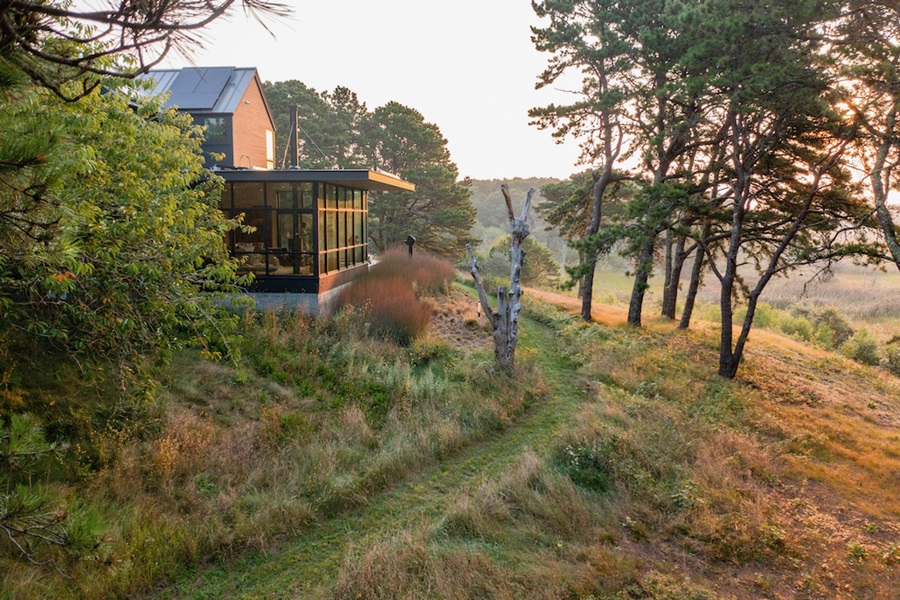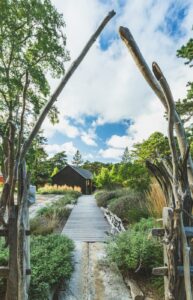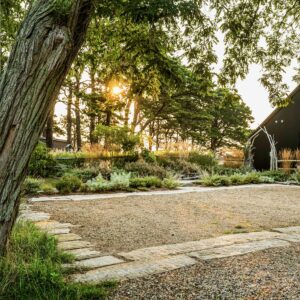Keith LeBlanc has focused for years on designing landscapes and gardens that eschew suburban ideals of clipped lawns and formal flower beds while seamlessly blending into our Outer Cape ecosystem. We asked the longtime Truro resident, who is principal of LeBlanc Jones Landscape Architects, to talk about the ways in which a property he designed for a local client makes a useful case study for helping any garden-maker be successful in working with our rich palette of plants and geology instead of against it. His concepts are transferable enough to give any size project, from a small village back yard to a property in the woods, a stronger relationship to the wildness that surrounds us.
Boundaries
“We think about edges from the get-go,” says LeBlanc. “You’ve heard the expression, ‘Good fences make good neighbors.’ But isn’t it more interesting for people not to know exactly where the edges are? I love to blur the boundaries so it’s not immediately apparent where things end or begin. On the other hand, sometimes it adds to the design to say this is an edge. Maybe it’s a very tight situation. That restriction might give us a design opportunity to do an interesting fence, or a hedge, or a looser hedgerow of mixed plants.

“We’re always trying to be less invasive in our projects, especially for larger properties like this one in Truro, which started out as an antique Cape with several additions and outbuildings. We want as little disturbance in the landscape as possible. Whether it’s an addition or putting up a new house, we’re very cognizant of how much disruption is required. Usually, a contractor will tell us their big trucks need 100 feet, 360 degrees around the house. But we counter that by identifying trees that we want to keep, or we ask if the cleared area has to be all the way around the house. In terms of the edges, anything we can save will preserve some of the valuable existing conditions and natural setting.
“Editing the edges is important while taking advantage of what’s right beyond your property. If you’re in a small back yard and the neighbors have a cloud of bayberry, why don’t you add one on your side that fits in with your design and borrows a bit of their yard? It makes both seem bigger. Let’s say there’s a fence — if they have a rose of Sharon on their side, put a rose of Sharon on your side. Your eye will connect them when you look out.”
Plants and Lawn
“When we were brought in on the project,” says LeBlanc, “the owners had a garden near the house with various perennials: artemisia, lavender, heather, and sedum next to an existing deck. But they told us they didn’t want to add more gardens that needed a lot of maintenance. Moving outward from the house to the views, there was a large lawn. We reduced its size and brought the edge of it closer to the house. Because we are in a conservation setback, we planted those areas with native grasses and shrubs. Closer to the house, we started to mix lavender with some of the ornamental grasses to tie the natural with the garden areas.
“Our firm has always been native happy,” says LeBlanc. “Twenty-five years ago, it wasn’t so, but now people are embracing ecological reasons as they’re making decisions.

“When it comes to lawn, we always ask our clients why they want it. Is it purely a visual statement? Or do they want it for kids or dogs to play on? If it were up to me, I would avoid lawns, but there are different kinds. There’s the high-maintenance lawn, where the lawn folks come and spray and fertilize. And then there’s a native mix that’s mowable, and it’s not all fescues, so the mow schedule isn’t once a week. We also have clients who are irrigation-conscious enough that they’re OK with the lawn becoming toasty in midsummer, even if it’s a summer house. In August, if it rains, then the lawn comes back. Generally speaking, lawns that allow some wild growth such as dandelions, crabgrass, and clover can be maintained by hand.”
Trees
“It’s educational to show our clients which trees are valuable and which are less so,” says LeBlanc. “Especially those that are invasive species or so diseased that they might fall on the house. A lot of urban areas have trees that have outgrown their usefulness. Removing a tree selectively along the edge can bring in a more interesting skyline.”
Materials
“Reuse is important to us,” says LeBlanc. “We used old bricks found on the site for new paving, pathways, and an apron. Homeowners love collecting driftwood and had made a garden arch of pieces gathered from the beach. Here they also created a kind of a ground cover of driftwood by laying it down horizontally so that plants can grow through and around it. We used reclaimed granite for the paving stones, which were once curbs. They have variable widths and an interesting roughness to them that ties into the landscape.”

Driveways and Parking Areas
“We rerouted the driveway, which used to run straight up the hill,” says LeBlanc. “So, reestablishing a new edge of natives there was important. The design zigzags probably more than I would normally do when laying out a driveway, but our clients were adamant that we keep all the trees. We designed the new driveway to have the strip of rough grass down the middle, like you see all over Truro. We just let whatever grows grow there so that it feels like you are driving up a dirt road to get to the house through pines and bayberry. The parking area is centrally located and visible between the new guest house and the main house. We made a rainwater permeable section of gravel, delineated by the granite paving stones, that morphs into the more flowery garden area.”

Conservation
“Anything within 100 feet of the resource area [a protected area such as a marsh or wetland] is in the conservation commission’s purview,” says LeBlanc. “Between 50 and 100 feet, the commission will allow you to do certain things if you can prove you’re improving the resource area. In this case, we got rid of lawn and we took out invasives. It helps that in our area there are a lot of conservation setbacks, because it makes homeowners think about native plantings in a different way. But we’re not going to only do what conservation tells us that we have to. We’re incorporating the concepts into the garden areas next to the house as well. That way the garden feels more at home in its environment, wherever your house is located.”
10 Natives That Blur the Edge of a Cape Cod Landscape
Shadbush/Saskatoon serviceberry (Amelanchier canadensis)
- Benefits: Early spring flowers, edible berries, and brilliant fall color
- Habit: Multi-stemmed shrub or small tree, offering both vertical and horizontal structure
Northern bayberry (Myrica pensylvanica)
- Benefits: Semi-evergreen with aromatic foliage and waxy gray berries birds love
- Habit: Dense, rounded shrub perfect for sandy soils and coastal conditions
Winterberry holly (Ilex verticillata)
- Benefits: Striking bright red berries in winter after leaves drop
- Habit: Deciduous, providing multi-season interest and excellent wildlife food source
Lowbush Blueberry (Vaccinium angustifolium)
- Benefits: Delicious berries, lovely spring flowers, and excellent fall foliage coloration
- Habit: Low-growing mat-forming shrub, perfect for natural ground cover
Inkberry holly (Ilex glabra)
- Benefits: Evergreen with dark green leaves, adaptable to a range of soil conditions
- Habit: Uniform, rounded, and can be used for both formal and informal settings
Little bluestem (Schizachyrium scoparium)
- Benefits: Attractive blue-green foliage that turns coppery orange in fall, providing texture and movement
- Habit: Clump-forming grass with airy seed heads, great for sandy soils
Northern arrowwood (Viburnum dentatum)
- Benefits: White flower clusters in spring, followed by blue-black berries and stunning fall foliage
- Habit: Versatile shrub that tolerates a variety of conditions from wet to dry soils
Sweetfern (Comptonia peregrina)
- Benefits: Fragrant, fern-like foliage, great for erosion control
- Habit: Low, sprawling shrub ideal for sandy or dry soils
Highbush blueberry (Vaccinium corymbosum)
- Benefits: Edible berries, attractive flowers, and vibrant fall colors
- Habit: Taller than lowbush blueberry, providing vertical interest and wildlife benefits
Bearberry (Arctostaphylos uva-ursi)
- Benefits: Evergreen ground cover with red stems, pinkish-white flowers, and bright red berries
- Habit: Spreading habit excellent for sandy soils and slopes, attractive to pollinators and birds



